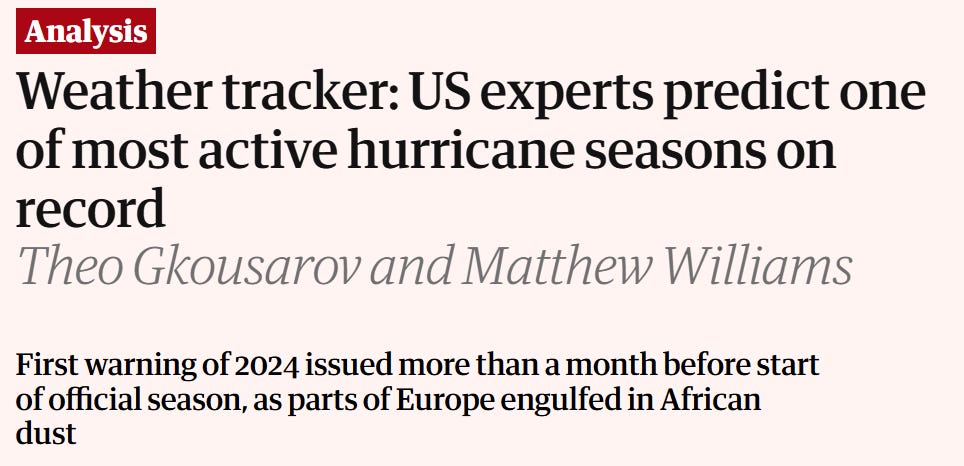The 2024 Hurricane Season...
How Alarmist Predictions and Simplistic Narratives Erode Public Trust
The 2024 Atlantic hurricane season has essentially concluded with 18 named storms, 10 hurricanes, and 3 major hurricanes. These numbers align with historical averages, falling far short of pre-season forecasts that portrayed the season as potentially "record-breaking."
A prominent climate scientist, Dr. Michael Mann publicly predicted an astonishing 33 named storms, doubling the long-term average and significantly overshooting the eventual total. Meanwhile, NOAA, generally considered a more measured and authoritative source, forecasted 17 to 25 named storms, including 4 to 7 major hurricanes. While NOAA’s predictions were closer to the observed values, they too leaned toward an overestimation of storm activity, particularly in the number of hurricanes.
These forecasts weren’t just statistical guesses; they were repeatedly amplified by media outlets as if they were certainties. Sensational headlines such as “Weather tracker: US experts predict one of most active hurricane seasons on record” from mainstream publications like The Guardian painted a dire picture, connecting the forecasts to anthropogenic climate change without adequately discussing scientific uncertainties.

This tendency to emphasize the worst-case scenarios raises questions about how media and scientific institutions communicate risks to the public.
Overestimations, Media Hype, and Public Anxiety
Dr. Mann’s prediction of 33 named storms deserves scrutiny not just for its inaccuracy but also for how it was presented. Mann has often used his platform to issue dire climate warnings, some of which have been criticized as overly speculative.
For example, he tied the 2024 hurricane forecast to climate change-induced record-high sea surface temperatures (SSTs), suggesting these alone could drive unprecedented storm activity. While elevated SSTs are indeed one factor in hurricane development, this ignores the role of other critical elements such as vertical wind shear, dry air intrusion, and atmospheric stability, all of which were prominent in suppressing storm formation during 2024.

Government institutions like NOAA also leaned heavily into the narrative of a hyperactive season. Their forecast of up to 25 named storms was presented with little emphasis on the uncertainties inherent in seasonal hurricane predictions. Instead, NOAA repeatedly highlighted anomalous SSTs and a strong El Niño, linking these conditions to increased storm potential. However, El Niño often suppresses Atlantic hurricane activity due to increased wind shear, a fact that received minimal attention in media coverage.
Media outlets amplified these dire forecasts with little critical analysis. Articles from MSM, warned readers to "brace for a brutal hurricane season," citing NOAA forecasts and Mann’s predictions. Words like "unprecedented" and "supercharged" were ubiquitous in headlines, leaving little room for nuance or skepticism. This type of coverage can create unnecessary panic and undermine public trust when forecasts fail to materialize.
Comparison to Historical Seasons: What 2024 Tells Us
The 2024 season was far from record-breaking.
Keep reading with a 7-day free trial
Subscribe to Irrational Fear to keep reading this post and get 7 days of free access to the full post archives.






